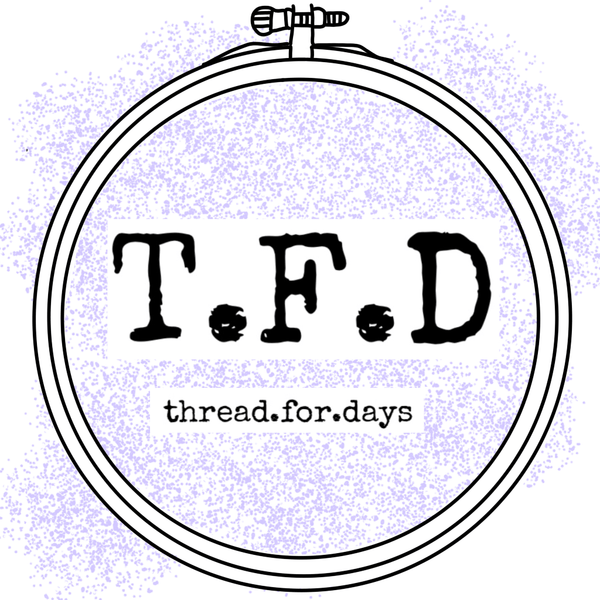looking to get into embroidery but don't know where to start? Don't even worry about it, here are 6 things to get you started.
When I started embroidering I ultimately started with most things I already had around the house. As I learned and expanded my skills I changed up what I was using. BUT, everyone starts somewhere and in this post I want to make it a little bit easier so here are 6 things you'll need to get started with embroidery!

The 6 things:
- embroidery hoop!
- needle
- floss/thread
- fabric
- means of transfer (pen/pencil/marker whatever)
- scissors
That's all, but, let me expand....
Embroidery Hoop

Most of the supply items above are things that you may already have around the house if you are into any other fabric arts, fiber arts, crafting, sewing etc. The hoop however is one that I needed to get before I could start embroidering.
There are a few different kinds of hoops, but the most common hoop (basically any crafting store) is the bamboo hoop (see from Michaels).
I started with the bamboo hoop, and i've grown to love it. If you find you are getting super into embroidery you can always explore alternative options like faux wood frames or have some customs made, but honestly the bamboo hoop is the cheapest and most accessible way to get started!
Embroidery Needle

Okay so, I may get some HEAT from the embroidery community, but I'm not here to gatekeep. Honestly, f you have sewing needles at home- feel free to use those bad boys instead of going out and purchasing new embroidery needles.
When I started embroidering I used what I had first and then expanded to other supplies. If you are planning on learning to embroider and already have some sharp large eyed needles- give those a go before you purchase some fancy DMC needles.
I will note though that sewing needles work fine if you are planning on using less thread (1-3 strands in a project as opposed to the full 6 strand floss) and if they are sharp. If they are on the duller side or you want to work with thicker floss- you may need to get a proper embroidery needle.
Floss/Thread

The embroidery floss kind of matters but, not really; I'll explain.
When I started embroidering and practicing my stitches I used the floss I had- which was dollar store children's bracelet making floss. Did it work for learning- absolutely, did I realize how awful it was when I eventually switched to DMC- also yes.
If you do have some floss lying around feel free to use it for learning; no need to buy things if it may not be your thing. However, I will warn you, old floss may break, split, and feel like absolute trash on a sensory level compared to DMC floss.
Fabric

One of the best things about embroidery is that fabric is fairly accessible. When I started embroidering I learned on quilting cotton. I had so much of it lying around from other projects, it was a great fabric to start with!
Really, any fabric you may have that is fairly taught and not too thick is great for learning. If you have some old bedsheets you were planning to get rid of; linen & cotton are excellent choices.
Alternatively, if you, like me, sew or work with other fabric arts, whatever taught and not too thick fabric you have lying around will also work.
Means of Transfer

Some may think this is absolutely unhinged, but when I started embroidering I used whatever stationary I had to transfer. As long as your lines are thin and easy to cover this works well for learning, basically anything can be used (when learning). Please note though- if you are using inks on your fabric and light threads there can be a possibility of staining so keep that in mind. However, when I was learning and starting embroidery I started with a basic ballpoint pen, thin tipped sharpie, even mechanical pencil, whichever worked best for the fabric I was using.
Alternatively if you are a sewist and have some charcoal transfer paper, this can work too on a very taught hoop.
Other options if you are worried about ink/lines on your hoop include the Sulky dissolvable paper or you can use an inexpensive heat erasable pen like the friction pilot if you are worried about lines in your piece.
Scissors
The beauty of embroidering and setting it in a hoop, on clothing, or even a patch, is that you can almost use any scissors available to trim excess fabric.
Prior to embroidering I did do some sewing so had some cheap fabric sheers that I used, but honestly, I have also used whatever sharp scissors i've had nearby.
Yes, even my butcher block scissors LOL.
No need to spend a fortune on this item!
Wrapping it all up...

Out of the many fibre arts embroidery art is relatively inexpensive to start in. The thread is cheap and easy to find, the supplies are accessible, and it is very forgiving.
These are the 6 things I started with, and there are so many more things in terms of supplies.
But if you are thinking about getting into embroidery- this is a good place to start!
Stay weird and wonderful pals,
~Kass
(Oh and also, if you want to learn I have other tutorials and really comprehensive patterns available for download! If you want all the supplies (minus transfer and scissors delivered to you, I also offer kits).

